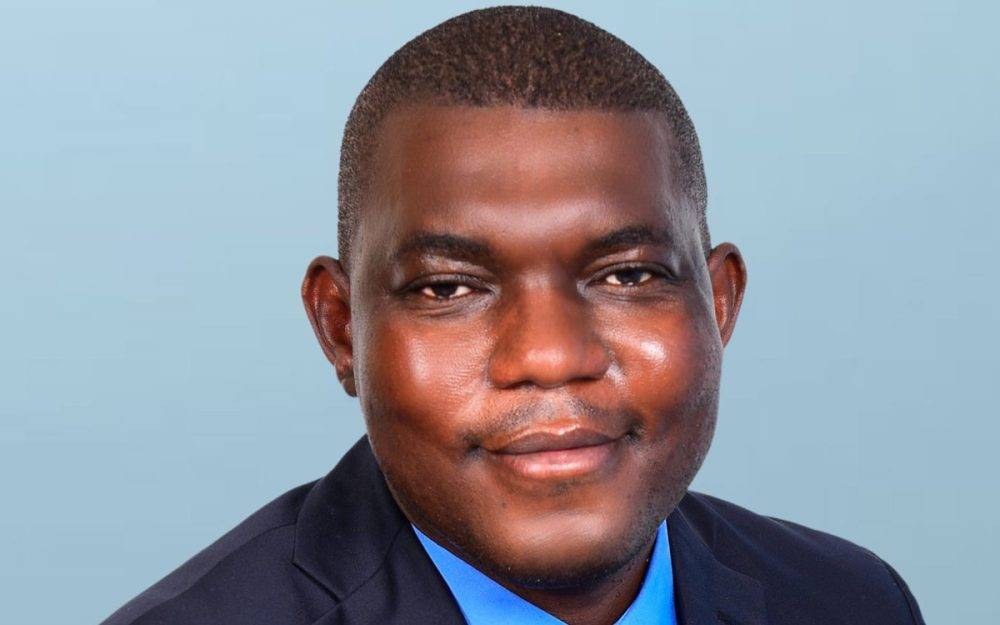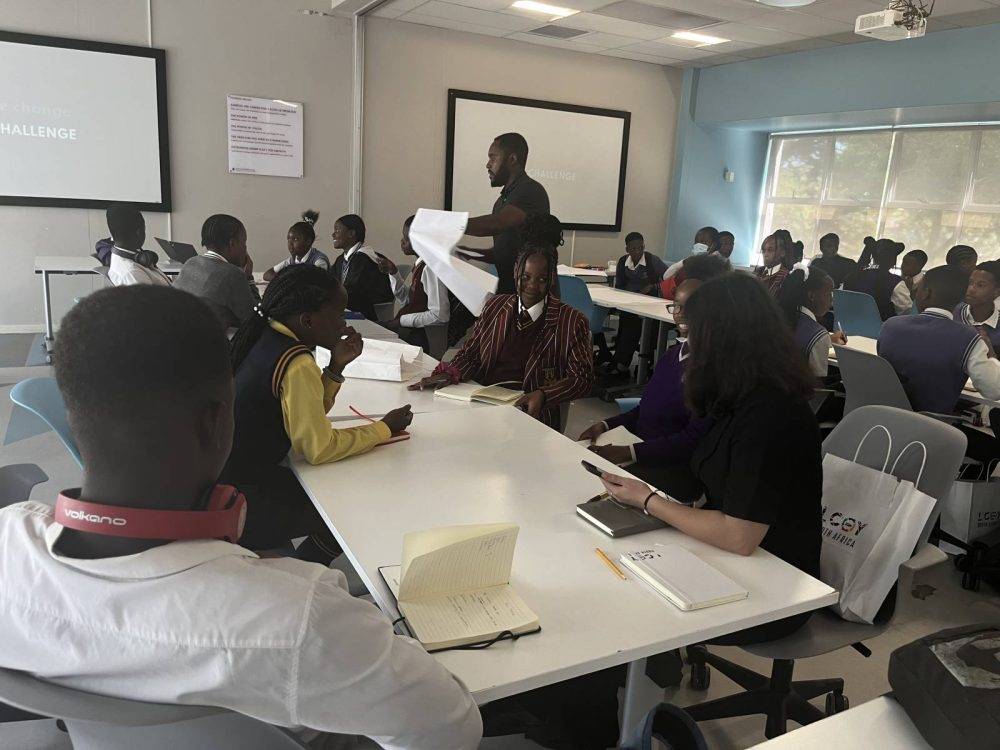Schoolchildren who participated in the Local Conference of Youth event held at the African Leadership Academy in Roodepoort.
LCOY 2024 aimed to provide youth aged 14 to 25 with the tools and knowledge to participate in climate policy and STEM-based solutions actively
The Local Conference of Youth (LCOY) South Africa 2024 post-event on October 18 at the African Leadership Academy in Roodepoort served as a vital platform for African youth to deepen their understanding of climate finance, the Just Energy Transition, and the role of STEM in addressing climate challenges.
The event was organised in collaboration with Climate Action Network South Africa (SACAN), the Global Shapers Community Tshwane Hub, the African Leadership Academy (ALA), the Department of Science, Technology and Innovation (DSI), the New Economy Hub (NEH), the Mail & Guardian (M&G), the African Climate Reality Project (ACRP) and the Next Einstein Forum (NEF). The event was held under the umbrella of YOUNGO, the official youth constituency of the United Nations Framework Convention on Climate Change (UNFCCC).
SACAN is part of the Climate Action Network (CAN), a worldwide network of over 1 300 Non-Governmental Organisations (NGOs) in over 130 countries. It is dedicated to championing the implementation of robust national policies, strategies, and actions aimed at addressing the impacts of climate change. SACAN strives to integrate the global climate agenda seamlessly into the local context of South Africa, aligning its efforts with the principles of Agenda 2030 and the Paris Agreement.
 The youth who attended the LCOY event were encouraged to participate in order to understand concepts like climate finance more thoroughly.
The youth who attended the LCOY event were encouraged to participate in order to understand concepts like climate finance more thoroughly.
This year’s theme focused on building youth engagement in climate negotiations, promoting an understanding of climate finance, and supporting the transition to a just, low-carbon economy. The audience participated via an app and the session deepened their understanding of climate change, climate finance and climate action.
South Africa can learn from Singapore
Mandry Ntshani, Director responsible for Africa Multilateral Cooperation, South Africa from the DSI said that we are all affected by climate change, and that Africa loses up to 2.5% of its GDP because of it. New initiatives and policies must be developed to address climate change, and innovation and technology can make an impact upon it.
Singapore is a good example of renewable energy, as it uses its waste to create electricity. South Africa is investing in renewables such as hydrogen and building electrical vehicles, but everyone must come on board; the youth must become the driving force behind addressing climate change.
Connecting science and humanity
Charles Lebon Mberi Kimpolo, Director of Industry Initiative and Head of the NEF, said he launched Young Africans Technology, a non-profit coding academy, to remember his roots, and where he came from. AIMS — the African Institute of Mathematical Sciences — is Africa’s first network of centres of excellence in mathematical sciences. The purpose of AIMS is to connect science and humanity, as science is for the betterment of people. NEF is an AIMS initiative, focused on convening Africa’s innovators to highlight breakthrough discoveries and to catalyse scientific collaboration for human development.
 Charles Lebon Mberi Kimpolo, Director of Industry Initiative and Head of the NEF.
Charles Lebon Mberi Kimpolo, Director of Industry Initiative and Head of the NEF.
South Africa is the birthplace of many great innovations and ideas, said Kimpolo, and the next Einstein may well come from here. He encouraged the youth to be bold, ask questions, be innovative, and challenge the status quo. Climate action requires mathematical models to know what the problems are; how to address them is a task of the youth. Both urgent collective action — and personal action — is required to combat climate change and its impact.
Climate finance
Thando Lukuko, Coordinator, SACAN, asked the members of the audience what they understood about climate finance. Participants joined up via an app, so that their answers were displayed on a screen on the stage. Climate finance is support for climate action, to reduce emissions and adapt to climate change impacts, and it is implemented via mitigation and adaptation strategies, said Lukuko.
Although Africa produces few emissions (4% of what the world produces), it suffers disproportionately from the effects of climate change, and has limited resources to adapt. Local solutions are required, and if equity was applied, finances would be forthcoming for, for instance, replacing infrastructure damaged by climate impacts.
To date, most financing comes from private companies, not governments, or it comes with debt attached. Climate finance can take the form of reducing emissions, for instance through clean energy technologies, or by building resilience and adaptation, for instance through early warning systems or flood and storm protection.
A game was then played, in which participants were asked what they would do if they were given R10 million to deal with climate change. Of the five choices: water conservation, renewable energy, climate smart agriculture, community awareness and infrastructure, renewable energy came out first.
- An audience member said renewable energy was the top choice for him because that is what causes climate change the most.
- On water conservation, the reason was that it would benefit many sectors like agriculture, and it will save lives by promoting sanitation practices
- Infrastructure was chosen because it would help to preserve people’s home and livelihoods
- Climate smart agriculture was the first choice for one participant because better types of crops would help to promote health and conserve resources. Africa has many droughts.
- Community awareness came first for one audience member because educating communities would help fight against climate change.
Why should the youth care about climate finance, was the next question Lukuko asked. The answers were about protecting the environment and future generations. “At some point we will become mothers and fathers,” said one participant, “and we don’t want this situation to occur again in the future”. Another remark was: “Young minds bring about fresh innovations.”
 The dynamic event encouraged the young attendees to think about how they can take part in effective climate action.
The dynamic event encouraged the young attendees to think about how they can take part in effective climate action.
Climate responsive budgeting is how certain departments and organisations work out what they will spend on climate financing. The Institute of Climate Justice has developed a toolkit for how to access climate finance, which includes understanding community needs, defining objectives and budgets, then developing pitches and targeting funders. Funding requires developing and maintaining good relationships, and we need to know what our rights are in order to know what climate finance should protect. These are human rights, the right to food, health, security and many others.
Think about one action you can take in your community to push for better climate finance use or policy changes, was the next question addressed to the audience. Answers included improving health, education about climate change, improving infrastructure and clearing up misinformation. One audience member said he would engage with the private sector. We can help with drawing up the nationally determined commitments towards climate action, said another audience member.
Lukuko recapped what had been covered on climate finance and closed proceedings.